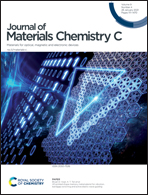Ti3+ self-doped dark TiO2 nanoparticles with tunable and unique dielectric properties for electromagnetic applications
Abstract
Robust, conductive and stable Ti3+ self-doped dark TiO2 nanoparticles (Ti4O7) called Magnéli phases are attractive in electromagnetic (EM) applications due to their tunable dielectric properties. Herein, Ti4O7 ceramic nanoparticles were successfully synthesized through a solvothermal and annealing method. To the best of our knowledge, this is the first time the dielectric and microwave absorption properties of Ti4O7 nanoparticles have been investigated in the field of EM applications, and Ti4O7 was evenly dispersed into polyimide (PI) by a heat pressing process. Interestingly, due to the formation of Ti3+ and oxygen vacancies during the annealing process, the special crystal structure will form electron channels that promote dark TN nanoparticles to possess a higher electrical conductivity and show outstanding dielectric loss compared to pristine TiO2 powders, endowing the 60 wt% Ti4O7/PI hybrid with an exceptional RL reaching −49.3 dB of 13.7 GHz at 1.25 mm thickness. These consequences indicate that highly conductive dark Ti4O7 composites will be good candidates for designing absorbers and other EM applications.



 Please wait while we load your content...
Please wait while we load your content...